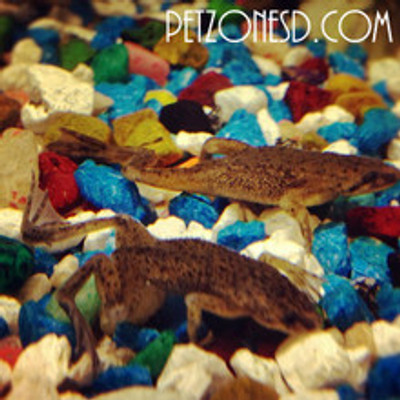Sunday Species Spotlight: African Dwarf Frog (Hymenochirus sp.)
Posted by Crystal Chan on on 31st Jul 2022
Sunday Species Spotlight: African Dwarf Frog (Hymenochirus sp.)
IUCN Conservation Status: Least Concern
Ecology
This friendly amphibian can be any one of four species in the Hymenochirus genus, all of which originate from Africa. Usually, the frogs you see in our stores are either H. boettgeri or H. curtipes, both of which are rated as “Least Concern” by the IUCN. [1] All the species in this genus are known to live in slow-moving waters (like swampy areas, shallow streams, etc.) of the tropical forests in Africa’s equatorial region and have been recorded in the Republic of Congo and the Democratic Republic of Congo. [1, 2, 3] Once fully mature, the African Dwarf Frog makes a living as a carnivorous scavenger. [4]
Fishery
Not much has been published about the fishery for this species, but it is usually aquacultured* for the pet trade. It is also a popular species for all kinds of scientific research, from studies on toxicology* to evolutionary history.
In Aquaria
As a fully aquatic frog, the African Dwarf Frog does not need land above water. However, as it is not a strong swimmer, it is recommended to avoid keeping it in tall tanks, or to add plenty of hardscapes/perches for it to stop and rest when going up for air. It is also recommended to keep a lid on your tank, as it can jump out otherwise.[1]
This frog is social, so keep it with at least one or more of its own kind! If you have a mixed-sex group, you may also hear the frogs “humming” to each other in your tank. [1]
As is the case with amphibians worldwide, Chytridiomycosis, the fungal disease caused by Batrachochytrium dendrobatidis (“Bd”) has been found in African Dwarf Frogs. [5] Although this disease is not contagious to humans, it is very dangerous to amphibians. NEVER release your frogs into the wild, and make sure to know the signs of Bd infection in your frogs and treatment options. [1]
*aquaculture: the farming of aquatic organisms
*Toxicology: the study of the harmful effects chemicals can have on people, animals, other living things, and the environment
Citations
[1] Stacey. (2021). African Dwarf Frog Care Sheet: Diet, Habitat, & More Great Tips for Beginners. https://reptile.guide/african-dwarf-frog/
[2] Masudi, F., Mali, M., Chifundera Kusamba, Z., Mlungu, A. M., Mizani, C. D., Katuala, P., Banda, G., Mbalitini, S. G., Ewango, C., Crispin, G., Tungaluna, G., Akaibe, B. D., Celestin, D., Mizani, P., Katuala, G., Banda, G., Mbalitini, C., Ewango, G., Crispin, G., … Dudu, A. (2019). Note on the Amphibians and Reptiles of the Mungbwalu (Ituri Province) and Mutwanga (Province of North-Kivu) in DRC. American Journal of Zoology, 2(2), 18–27. https://doi.org/10.11648/j.ajz.20190202.11
[3]Jackson, K., Zassi-Boulou, A.-G., Mavoungou, L.-B., & Pangou, S. (2007). Amphibians and Eptiles of the Lac Télé Community Reserve, Likouala Region, Republic of Congo (Brazzaville). Herpetological Conservation and Biology, 2(September), 75–86.
[4] Olsoon, R., & Österdahl, L. (1960). Aquarium Behaviour and Breeding of Hymenochirus. Nature, 188(1896), 794–796.
[5] Murphy, B. G., Hillman, C., & Groff, J. M. (2015). Chytridiomycosis in dwarf African frogs Hymenochirus curtipes. Diseases of Aquatic Organisms, 114(1), 69–75. https://doi.org/10.3354/dao02851

